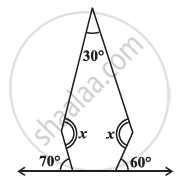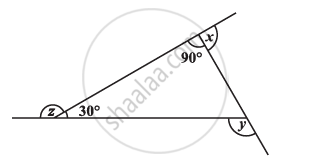Advertisements
Advertisements
प्रश्न
In the following figure, P is the mid-point of side BC of a parallelogram ABCD such that ∠BAP = ∠DAP. Prove that AD = 2CD.

उत्तर
Given in the question, in a parallelogram ABCD, P is a mid-point of BC such that ∠BAP = ∠DAP.
To prove that AD = 2CD
Proof: ABCD is a parallelogram
So, AD || BC and AB is transversal, then
∠A + ∠B = 180° ...[Sum of cointerior angles is 180°]
∠B = 180° – ∠A ...(i)
Now, in triangle ABP,
∠PAB + ∠B + ∠BPA = 180° ...[By angle sum property of a triangle]
`1/2 ∠A + 180^circ - ∠A + ∠BPA = 180^circ` ...[From equation (i)]
`∠BPA - (∠A)/2 = 0`
`∠BPA = (∠A)/2` ...(ii)
∠BPA = ∠BAP
AB = BP ...[Opposite sides of equal angles are equal]
In above equation multiplying both side by 2, we get
2AB = 2BP
2AB = BC ...[P is the mid-point of BC]
2CD = AD ...[ABCD is a parallelogram, then AB = CD and BC = AD]
APPEARS IN
संबंधित प्रश्न
Find the angle measure x in the given Figure


Find x + y + z
ABCD is a parallelogram in which ∠A = 70°. Compute ∠B, ∠C and ∠D .
If PQRS is a square, then write the measure of ∠SRP.
One angle of a quadrilateral is of 108º and the remaining three angles are equal. Find each of the three equal angles.
The angle between two altitudes of a parallelogram through the vertex of an obtuse angle of the parallelogram is 60º. Find the angles of the parallelogram.
The angles of a quadrilateral are in the ratio 1 : 2 : 3 : 4. The smallest angle is ______.
Which of the following can be four interior angles of a quadrilateral?
The angles P, Q, R and S of a quadrilateral are in the ratio 1:3:7:9. Then PQRS is a ______.
In a quadrilateral PQRS, ∠P = 50°, ∠Q = 50°, ∠R = 60°. Find ∠S. Is this quadrilateral convex or concave?
